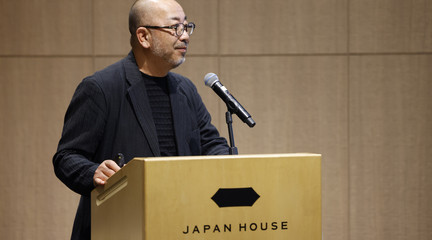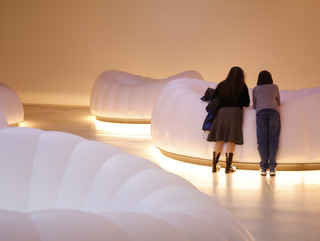
Hitoshi Abe and xLAB bring "Designing with Disaster" exhibition to Japan House Los Angeles
Jan 23, 2023
How can cities best manage risk and become more resilient in the face of climate change-fueled natural disasters? That question is at the heart of the global ArcDR3 research partnership, coordinated by UCLA Department of Architecture and Urban Design Professor Hitoshi Abe and the research team at xLAB. Now, ArcDR3 and xLAB have distilled three years of research and design into the publication FireCity FireLand: Towards a Regenerative Urbanism, and Abe has curated the exhibition Designing with Disaster: Stories from Seven Regenerative Cities, on view at Japan House Los Angeles from January 27 through April 4, 2023. The book and exhibition present the new paradigm of "regenerative urbanism": anticipatory urban design that prepares for inevitable disasters and creates climate-resilient environments—speculating upon new visions for cities affected by or anticipating these threats.
A global collaboration, ArcDR3 (Architecture and Urban Design for Disaster Risk Reduction and Resilience) aims to integrate theory, research, practice, and design, elevated by insight and case studies from around the world. FireCity FireLand and related exhibitions and symposia demonstrate the research and collaboration accomplished thus far by ArcDR3’s partners: IRIDeS at Tohoku University; Miraikan, the National Museum of Emerging Science and Innovation in Japan; and eleven universities across the Pacific Rim.
The FireCity FireLand publication illustrates ArcDR3's design research and strategies, ranging from wildfire preparation in California to post-tsunami reconstruction in Japan. The Designing with Disaster exhibition invites the public to experience the research in three dimensions, and is organized by three physical-conceptual frames: Pillars encompass a space for visitors to explore statistical data on areas in crisis; Cloud floats over the exhibition gallery with projected images and data that demonstrate the need to coexist with environmental risks; and eight glowing Wells provide an immersive physical experience as visitors peer over the soft walls to see and hear video testimonials about Tohoku, Japan's resilience.
"As the culmination of four years of collaborative research and design, the exhibition aims to inform the public about the work by the ArcDR3 initiative and this concept of Regenerative Urbanism in order to inspire the collective imagination and expand possibilities for moving forward," Abe observes.


“We’re pleased to share this forward-thinking collection of urban design strategies in partnership with an international coalition of scholars, architects, and designers,” said Yuko Kaifu, president, JAPAN HOUSE Los Angeles. “These efforts, inspired by the resiliency of the Tohoku people, highlight positive ideas that can evolve from the aftermath of a natural disaster. We hope this work becomes a valuable guide for the global community and helps mitigate the unique disaster potential that exist wherever our visitors reside.”
Collectively, the book and exhibition demonstrate regenerative urbanism as the possibility of symbioses between humans, nature, and the built environment and a paradigm that acknowledges the inevitability of not just natural disasters, but disaster cycles. Prompted by a rapid increase of nature-instigated disasters and climate change, this paradigm looks beyond the two prongs of pre-disaster, defensive-oriented maintenance and post-disaster rescue and restoration. Instead, regenerative urbanism anticipates and incorporates the effects of disaster through innovative urban design strategies, improving environments during normal conditions, and reducing the severity of disaster risk during an inevitable crisis. To this end, regenerative urban design strategies are mitigatory and anticipatory, embedding adaptability, mutation, and symbiosis in their methods and techniques to promote a more robust, balanced, and equitable society.
The exhibition’s seven hypothetical “cities” illustrate how these strategies might play out on the ground. A “Biophilic City” shows natural processes, ecosystems, and especially plant life within the city symbiotically integrating in novel forms; the “Hydroactive City” presents mechanisms of absorbing, storing, and distributing water to support urban life and coastal communities embracing new forms of livelihood and commerce; similarly, the “Archipelagic City” is distributed across elevated islands, protected from fire and rising tides.
Elsewhere, the “Pyroactive City” confronts wildfire risk; the “Dialogic City” centers dialogue and cultural tradition as integral to urban evolution and a more balanced, harmonious society; the “Chronosystemic City” breaks the urban grid into components that can be flexibly rearranged; and the “Nomadic City” opens novel forms of mobility and transit, with streets, highways, and rivers becoming sites of refuge and habitation.


UCLA research is threaded throughout these proposals. At UCLA AUD, Professor Hitoshi Abe's research studio collaborated with Professor Jeffrey Inaba's research studio to focus on fire-risk reduction and fire resilience. Students whose research and work are included in Living with Disaster include Andrew Gonzales, Yuqi Zhang, Amy Robles, Bella Rosa, Austin Ng, Molly Yiwei Qian, Xu Lee Wu, Daniel Lee, Tianyang Xu, and Hanxue Wu.
“Soon to be tested at the fiery interfaces between nature and artifice, between ungovernable wilderness and governable constructs, the combinatory design and planning techniques of a regenerative urbanism will flicker between software and hardware,” Abe writes in FireCity FireLand. “Just as architecture is a technical pursuit that shapes social, economic, and political life, we look at fire in both its technical dimension and its impact on civic life.”
Abe and Inaba’s UCLA AUD studios have drawn on the expertise of scholars from across UCLA, among them Dr. Ali Mosleh, Distinguished Professor and Evelyn Knight Chair in Engineering, as well as Director of the B. John Garrick Institute for the Risk Sciences; Dr. Saeed Nozhati, a postdoctoral scholar at the Garrick Institute; Kian Goh, Assistant Professor of Urban Planning; and Adjunct Assistant Professor Chandler McWilliams of the Department of Design Media Arts.
Public programming is integral to ArcDR3's mission of conducting research and design in parallel, and creating a continuous loop of collaboration and dialogue. In April 2022, ArcDR3 produced the symposium New Visions for Regenerative Urbanism and the complementary exhibition Living With Disaster: Stories from Seven Regenerative Cities, held in Tokyo's Muromachi Mitsui Hall & Conference. The symposium, New Visions for Regenerative Urbanism, took place on April 8 in Tokyo’s Muromachi Mitsui Hall, and was livestreamed globally; it was composed of a “Big Table” and “Small Table” format, whose non-hierarchical configuration seeks to flatten the relationship between participant-presenters and audience and encourage discussion. A variety of AUD faculty participated in the symposium, including Hitoshi Abe, Mariana Ibañez, Mohamed Sharif, Michael Osman, and Jeffrey Inaba. They were joined by Kian Goh and former xLAB Coordinator Lena Pozdnyakova, alongside experts from around the world. Currently, the program is collaborating with agencies in Japan to address the reconstruction of the areas around Fukushima devastated by the Great East Japan Earthquake and Tsunami.
Like the April 2022 exhibition, the forthcoming Designing with Disaster exhibition at Japan House Los Angeles presents a powerful and optimistic array of innovative urban designs focused on withstanding natural and human-instigated disasters while simultaneously responding to the multiple hazards of climate change. Importantly, the proposals do not merely reflect reactionary and defensive planning and design strategies but rather demonstrate the possibility of new symbioses between humans and the natural and constructed worlds. In doing so, each proposal forms a part of a global mosaic of regenerative urbanism, framing renewed possibilities for ecological and sociological ethics, and laying the groundwork for a future in which communities not only survive natural disasters but thrive in spite of them.
Learn more about the book, exhibitions, symposiums, and related projects via ArcDR3’s project website.
FireCity FireLand is generously supported by UCLA’s Chancellor’s Arts Initiative, including contributions from Vice Chancellor Roger Wakimoto and the Office for Research and Creative Activities.
Related Faculty |
Hitoshi Abe |
Related topics |
Building Typologies, Urban Strategy |










- Opening night at Japan House LA for "Living with Disaster"
- Opening night at Japan House LA for "Living with Disaster"
- Opening night at Japan House LA for "Living with Disaster"
- Professor Abe (center) dialogues with AUD's Carlo Sturken and UCLA Terasaki Center's Marti McElreath and Christian Rodrigues
- Professor Abe (second from left) discussing the exhibition with architect Andrew Zago; Cindy Fan, UCLA Vice Provost for Global Affairs; and Donald Bates, Chair of Architectural Design and Associate Dean, Melbourne School of Design
- Opening night at Japan House LA for "Living with Disaster"
- Opening night at Japan House LA for Living with Disaster"
- Professor Abe offers remarks during the opening reception for "Living with Disaster"
- Kenko Sone (Consul General of Japan to Los Angeles) with Professor Abe
- Opening night at Japan House LA for "Living with Disaster"